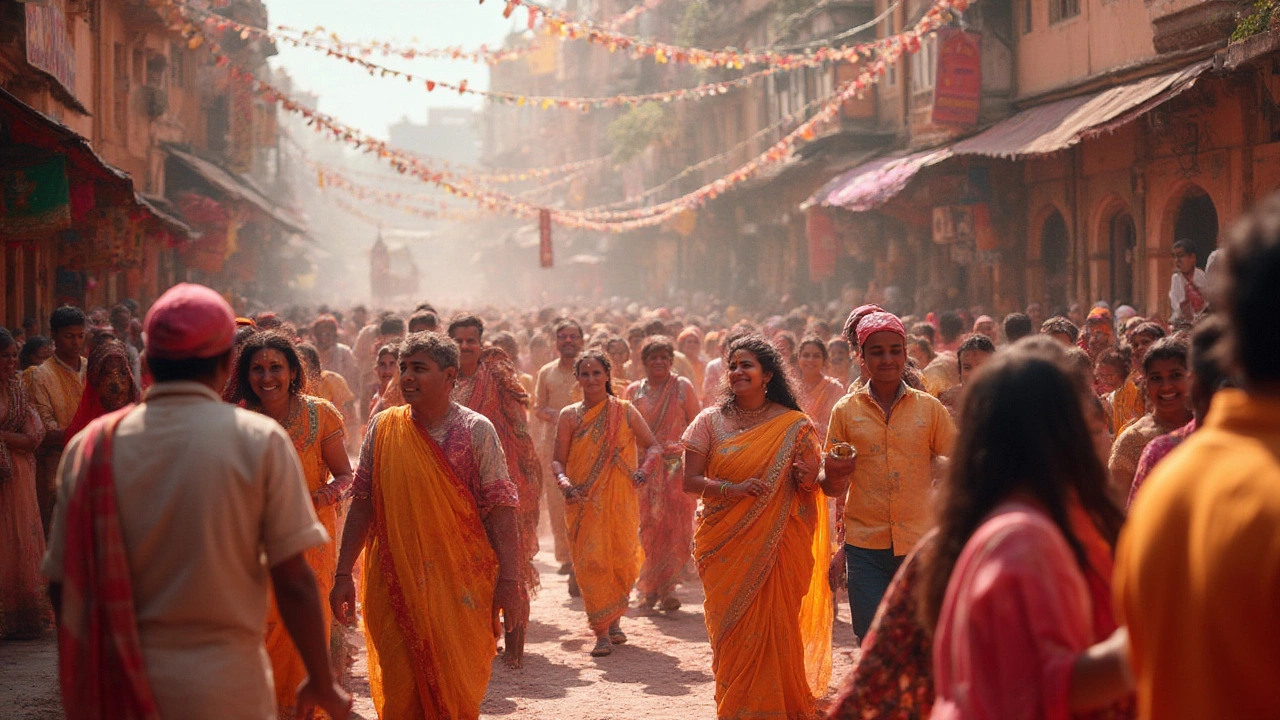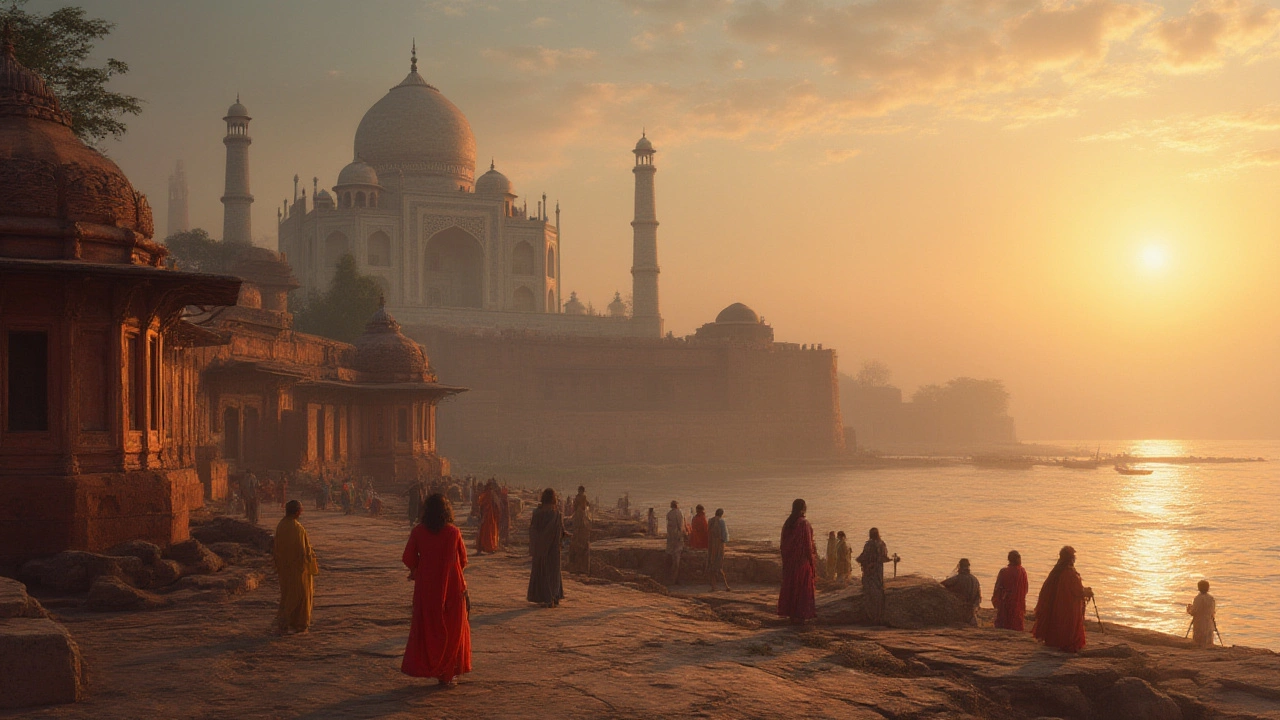What Makes India Special: Culture, Food, Diversity, and Heritage
 Jul, 10 2025
Jul, 10 2025
Ever tried to describe India to someone and found yourself running out of words? Every visit to a chaai stall, every crowded metro ride, each family dinner, and cricket match just adds new colors to the answer. India isn’t just a place you visit. It’s a sensation you feel—louder than the Delhi traffic, more flavorful than grandma’s biryani, and warmer than a Rajasthan summer. I still remember my son Aarav’s first monsoon shower on the balcony, his face lighting up like he’d seen magic. That’s what living in India feels like most days—a burst of surprise, layered with stories, and spiced with contradictions that somehow work.
An Ocean of Diversity: Languages, People, and Religions
Step off the plane in Delhi, and you’re greeted by Punjabi one minute, Hindi the next, and maybe a bit of Tamil if your driver is from Madurai. India is home to more than 1.4 billion people, but it’s the 121 major languages and 270-plus mother tongues that really scramble things up. In my family alone, WhatsApp groups flip between Hindi slang and English memes—sometimes in the same sentence. You can travel a state away and encounter totally different food, clothes, festivals, and even driving styles. The 28 states and 8 union territories are like mini countries with their own identities. Where else do you find schoolkids celebrating Pongal in Tamil Nadu, harvest festivals in Punjab, and Onam in Kerala all in one nation?
Religion adds another layer. Hinduism may be the majority, but you’ll hear church bells next to temple gongs and mosque calls. India has the third-largest Muslim population in the world, thousands of Christian communities, millions of Sikhs, Buddhists, Jains, and even a thriving group of Jews in parts of Mumbai. The festivals calendar is wild—you get more official holidays than in probably any other country. Holi turns cities into rainbows, Diwali lights up the night sky, and Eid is celebrated with collective joy and tons of biryani. Even over disagreements and debates (and yes, we have a lot!), there’s always a willingness to accept and absorb each other’s customs. If you ever see a wedding procession in a small town where Catholic priests are dancing to Bollywood beats with a temple pujari, that’s just a regular Tuesday here!
But here’s an honest tip—don’t expect this diversity to be only peaceful or smooth. There’s a ton of difference and sometimes, plenty of arguments. But, there’s also this every day, lived coexistence that really is something rare on the global stage. More than 80% of Indians say they have close friends from other religions, according to a Pew survey in 2021. It’s normal to share lunchboxes in school or office with friends from different backgrounds, with everyone debating which pickle is the spiciest.
Food: A Journey in Every Bite
Walk into any home, any street, any five-star hotel, and you’ll smell India. Some people say “Indian food” like it’s one thing, but honestly, even the samosas taste different in Amritsar vs Chennai. The sheer range is enough to make your head spin: 500+ varieties of desserts alone, hundreds of types of dal, and chaats that would make your taste buds weep with joy. If you’re used to dull sandwiches, brace yourself. Here, breakfast could be aloo paratha with homemade butter if you’re in the north, crisp dosa with sambar down south, misal pav in Maharashtra, or steaming momos if you’re feeling like a Delhi hipster.
Even after years in Delhi, I still stumble on dishes I’ve never tasted. Just last week, a friend got me Bengali “panta bhat”—fermented rice with green chillies. Honestly, it smelled a bit odd, but the zing? You won’t believe it. Every region uses local grains and vegetables—so roti, rice, millets, or even sago pearls turn into festival feasts. Street food deserves its own fan club. Delhi’s golgappa challenge (who can eat the most without burning up?), Kolkata’s kathi rolls, Lucknow’s kebabs—name a dish, and you’ll find it remixed, regionalized, and better than the last time you tasted it.
Worried about spice? People here have tricks—drink lassi to cool your throat, eat a bit of sugar after your meal, or load up on salad (yes, it works). Also, there’s something deeply social about Indian food. It’s almost always served family-style, with people using the same bowl, hands, and laughter stretching across the table. The best part? Food is an emotion—every grandmother here has a recipe that “cures colds, heals heartbreak, and brings family together.”
Indians are also expert innovators with food. Got leftovers? It’ll get transformed into parathas or pakoras the next day. Vegan, gluten-free, paleo? You can find it, hidden in traditional recipes long before these trends got big elsewhere.

Ancient Heritage and Mind-Blowing Traditions
You know those Instagram-perfect palaces and forts that pop up in travel lists? India’s past is everywhere, not just locked up in museums but alive in real streets. The oldest city in the world still buzzing with life? Varanasi. That’s right, it’s older than Athens or Rome, and people still crowd the ghats every night for a fire-lit Ganga Aarti that gives you goosebumps. Step out to Rajasthan and you’ll find palaces massive enough to get lost in, each with its own story of love, war, or betrayal.
Look at the ancient science and math roots. The concept of zero, algebra, trigonometry—so many fundamentals sprang up in India before the rest of the world caught on. Ayurveda, the oldest holistic health system, is still part of daily life; neem and turmeric aren’t just Instagram trends for us, they’ve been family remedies for centuries. The world’s first university? Nalanda, 5th century CE, taught students from as far as Greece and China. If you like numbers, the Indian Railways runs more than 65,000 km of tracks, and India’s postal network has the most post offices on the planet, including a floating one on Dal Lake in Kashmir. Wild, right?
Cultural traditions aren’t just antiques—they’re ways people still live. Arranged marriages are common, but Tinder is also super popular. We still do paath (prayers) at home, but watch Netflix with subtitles. There’s an unspoken rule about “jugaad”—fixing things on the fly when nothing else works. DIY is an art here, whether it’s fixing a scooter with a shoelace or throwing together a last-minute party when friends show up unannounced. Innovation and tradition somehow go together all the time.
Let’s not forget clothing. Every state has its own traditional dress—sarees in more styles than you can count, kurta-pyjamas, lungis, and salwar kameez. On special days, you can see people step out in the brightest, most intricate outfits, like Holi’s white kurtas or the flashy sherwanis you see at weddings. There's a pattern and embroidery type unique to almost every region.
Modern India: Youth Power and Global Influence
A lot of people still imagine India as all elephants and temples, but the place is running on youthful energy. Median age? Just 28. A lot of the world’s tech brains—think of CEOs at Google, Microsoft, Adobe—hail from Indian classrooms. India is now the third-largest startup hub globally and the number of unicorn startups is rising fast, crossing 100 by 2024. If you ever visit Bangalore, you’ll hear startup pitches being made over filter coffee in tiny cafes from morning till night.
Bollywood and cricket? Oh boy, they’re not just hobbies, they’re parallel religions. The reach of Indian cinema goes beyond language — people in Russia, Africa, and even South America know Shah Rukh Khan’s face. The Indian Premier League (IPL) pulls in more viewers than the Superbowl, and kids in every alley want to be the next Virat Kohli. There’s a stat that in 2023, IPL’s viewership crossed 520 million, making it one of the world’s most-watched sporting events.
Globally, Indian soft power is everywhere. Yoga started here and now has a dedicated day celebrated by the United Nations. Indian food joints have mushroomed in London, New York, Sydney—you’re never far from butter chicken. Teachers, doctors, engineers—millions of Indian professionals help keep the world running. Even in science and space, India surprised the world by becoming the fourth country to land on the Moon (Chandrayaan-3, 2023), and it was done on a shoestring budget compared to others.
So what tips do you need if you want to really experience India?
- Let go of the need to control everything—the chaos here is a feature, not a bug.
- Say yes when someone offers you food at their home—you may just taste something unforgettable.
- Travel beyond the big cities—small towns and villages have their own magic.
- Ask questions. People love to share stories, especially if you’re curious and polite.
- Embrace the noise and crowds; sometimes, in the chaos, you find the best stories.
India’s massive variety, age-old traditions, food, and youthful ambition turn every day into an adventure. Whether you’re walking by ancient temples or grabbing a latte at a shiny mall, the blend of old and new never gets dull. There are places you visit, and then there’s India—where you sometimes end up finding a whole new part of yourself.
| Aspect | Data |
|---|---|
| Population (2025 est.) | 1.43 billion |
| Official Languages | 22 (but 121 major recognized languages) |
| Largest Cities | Mumbai, Delhi, Bengaluru, Kolkata, Chennai |
| Religions | Hinduism, Islam, Christianity, Sikhism, Buddhism, Jainism (others, too) |
| UNESCO Heritage Sites | 42 |
| Startup Unicorns (2024) | Over 100 |
| World's Largest Postal Network | Yes (155,000+ post offices) |
| Annual Holidays | More than 30 (regional and national) |